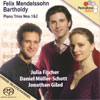Mendelssohn Piano Trios Nos 1 and 2, Opp 49 & 66
Here's a starry line-up who really know how to play chamber music
View record and artist detailsRecord and Artist Details
Composer or Director: Felix Mendelssohn
Genre:
Chamber
Label: Pentatone
Magazine Review Date: 10/2006
Media Format: Super Audio CD
Media Runtime: 59
Mastering:
Stereo
DDD
Catalogue Number: PTC5186 085

Tracks:
| Composition | Artist Credit |
|---|---|
| Piano Trio No. 1 |
Felix Mendelssohn, Composer
Daniel Müller-Schott, Cello Felix Mendelssohn, Composer Jonathan Gilad, Piano Julia Fischer, Violin |
| Piano Trio No. 2 |
Felix Mendelssohn, Composer
Daniel Müller-Schott, Cello Felix Mendelssohn, Composer Jonathan Gilad, Piano Julia Fischer, Violin |
Author: Harriet Smith
Chamber music with star players doesn’t always work: lack of rehearsal time or oversized egos can often lead to performances high on surface glitz but low on understanding. Not here though: these young artists, already making waves in their individual careers, give us a recording of Mendelssohn’s delectable piano trios that sparkles and fizzes from the outset.
The opening of the D minor Trio No 1 is a touch simpler than the Florestan’s recent acclaimed reading but its urgency sweeps you along. They are particularly fine in the scherzi of both trios, with delightful portamenti in the D minor which seem to say “look how easy this is”. In the finale, the new trio set off at a dancing pace; the Florestan are a touch steadier, which makes for an even more explosive contrast as the movement hots up.
The C minor Trio has long lived in the shadow of the D minor. It’s darker, slower to reveal its secrets. The new version fully captures its ruggedness, the way that melodies are hewn from the musical material, rather than simply emerging complete as in No 1. The only real quibble is their spacious tempo for the second movement, a Venetian gondola song in all but name. It’s played with great tenderness but does seem rather over-extended. And in the finale the 1960s-vintage Beaux Arts Trio are more characterful. But all in all, this new recording is irresistible, with the three players caught in a wholly natural ambience. It’s always a good sign when you don’t want to stop playing a disc long enough to write about it.
The opening of the D minor Trio No 1 is a touch simpler than the Florestan’s recent acclaimed reading but its urgency sweeps you along. They are particularly fine in the scherzi of both trios, with delightful portamenti in the D minor which seem to say “look how easy this is”. In the finale, the new trio set off at a dancing pace; the Florestan are a touch steadier, which makes for an even more explosive contrast as the movement hots up.
The C minor Trio has long lived in the shadow of the D minor. It’s darker, slower to reveal its secrets. The new version fully captures its ruggedness, the way that melodies are hewn from the musical material, rather than simply emerging complete as in No 1. The only real quibble is their spacious tempo for the second movement, a Venetian gondola song in all but name. It’s played with great tenderness but does seem rather over-extended. And in the finale the 1960s-vintage Beaux Arts Trio are more characterful. But all in all, this new recording is irresistible, with the three players caught in a wholly natural ambience. It’s always a good sign when you don’t want to stop playing a disc long enough to write about it.
Discover the world's largest classical music catalogue with Presto Music.

Gramophone Digital Club
- Digital Edition
- Digital Archive
- Reviews Database
- Full website access
From £8.75 / month
Subscribe
Gramophone Full Club
- Print Edition
- Digital Edition
- Digital Archive
- Reviews Database
- Full website access
From £11.00 / month
Subscribe
If you are a library, university or other organisation that would be interested in an institutional subscription to Gramophone please click here for further information.




